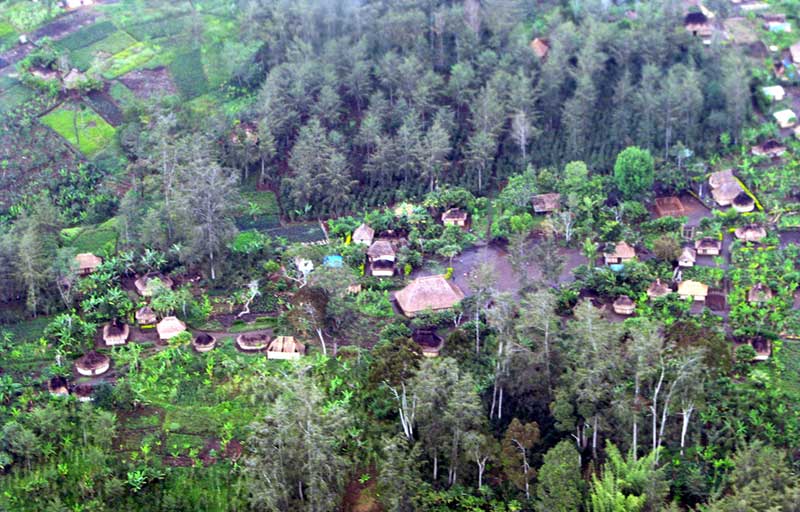Chapter 9 - Opposite paths to success
deals with some societies that have survived for many generations, despite facing some of the same challenges that we've looked at so far. Profiled in detail:
- New Guinea
- Tikopia, a small island (1.8 sq miles) in the Pacific
- [Not assigned] Tokugawa
They each did unique things with forestry / trees.
Bottom-up vs Top-down
Diamond discusses Archaeologist Patrick Kirch's studies of many Pacific islands
- A small island of 1.8 sq miles, Tikopia has been occupied for more than 3,000 years.
- A medium-size island of 27 sq miles, Mangaia, had a deforestation-triggered collapse.
- A large island of 288 sq miles, Tonga has been operating "more or less sustainably" for 3,200 years.
Q1: In the U.S. many of the "top down" approaches to solving problems in society are associated with the federal government. But what are some bottom up organizations? Describe 2 bottom up organizations that you are familiar with from where you grew up.
One of you put it this way:
[A] bottom up [organization is] when people work together to solve their own problems.
- Bottom-up organizations: Organized and staffed at the local level. $\Rightarrow$ Not national organizations.
- The goal of these organizations is to solve problems in society. $\Rightarrow$ Not (most) private companies. Their primary goal is to make money.
Diamond gives the example of a neighborhood crime watch group, aiming to solve problems of crime.
Other examples include school PTA / PTO organizations, or groups helping at the local level alleviate poverty. E.g. in Goshen, "The Window" (food pantry) or "La Casa" (financial education, "help-a-house" volunteers doing house repairs, and grants to help poor folks own/maintain their own homes).
Farming in New Guinea
New Guinea: highland village

Q2: New Guinea has been farmed for thousands of years. But unlike Easter Island, it is still quite fertile. Diamond says that New Guinea farmers have discovered, by trial and error, many ways to keep the soil fertile. Describe 2 techniques that New Guinea farmers use to maintain or improve soil fertility (not including trees).
- Water drainage
- They "added weeds, grass, old vines, and other organic matter to the soil as compost at up to 16 tons per acre"
- Crop rotation
 Q3: The other major innovation that New Guinea farmers have figured out is "silviculture" or tree agriculture, most notably using Casuarina oligodon or 'She Oak" trees. Describe 2 ways that silviculture benefits New Guinea farmers.
Q3: The other major innovation that New Guinea farmers have figured out is "silviculture" or tree agriculture, most notably using Casuarina oligodon or 'She Oak" trees. Describe 2 ways that silviculture benefits New Guinea farmers.
You've heard of *fertilizer*? All fertilizers contain nitrogen. All plants need nitrogen to grow. You know that air is mostly nitrogen. There are a handful of plants that can pull it out of the air directly. Most plants get it some other way:
- Casuarino Oligodon is one of the few plants that perform the trick of "fixing" nitrogen directly from the atmosphere. (See our Soil fertility topic.)
- Their leaves are also rich in nitrogen, and can be added to a garden.
- Their roots grow deep and stabilize the soil, keeping it from washing away (erosion) in the heavy rains of New Guinea.
- Trees are themselves a useful agricultural product resulting in timber which can be used for building or sold.
See Drawdown's Land Sink sector solutions for some modern solutions related to silviculture, or growing food on / with trees, such as
- Perennial staple crops
- Multistrata agroforestry
- Tree intercropping
- Silvopasture
Tikopia
Q4: Tikopia is a Pacific island that, unlike Easter Island, gets a good share of volcanic ash and dust blown in from Asia to enhance their agriculture. But they have also made major changes. Describe the Tikopians' diet in the early years of settlement, and what they eat more recently.
Q5: But even though Tikopia has been supporting people for thousands of years, there are limits to how many people the island can support. What are your reactions to the ways that Tikopians have come to control their population? Do you think morality is or should be universal or depends on the situation humans are in?
The Tikopians used a variety of ways to keep their population in check: Read about these, if you haven't already.
Japan is a much larger country. But is very mountainous so it has a small proportion of arable land. This means it has also run up against the limits of farmable land generations ago.

Jizo statues at Zojo-ji Temple Gorgo - Gorgo, Wikimedia Commons, Public Domain.
Farm families used Abortion and infanticide to limit their population. This is not something that comes easy to humans! Japanese Shinto Buddhism developed the ritual of Mizuko Kuyo to acknowledge these "water babies".
Q6: What other thoughts and questions occurred to you while reading this material?
Population density of 800 people / sq mile came up, compared to Goshen at 2,100 / sq mile.
At 800 people per square mile: How much land is that in acres / person?
show / hide
Flip this over to get: $$\frac{\text{1 sq mile}}{\text{800 people}}= \frac{1}{800}=0.00125\text{ square miles / person}.$$ Now you can look up the conversion factor from square miles to acres, or directly Google: 0.00125 square miles in acres to find...
This small house on 12th St (about a mile from GC) occupies 1/4 acre. But few Goshen people are raising all of their own food on the land they occupy in town...
Q6: What did you wonder about?
A number of folks wondered how and why people inhabited these islands, or why they didn't just leave [to cope with overpopulation].
Wayfinding - how Polynesians found islands (in a vast ocean). A large genetic study (Smithsonian) is evidence of the order and approximate times when different Pacific islands were settled by the Polynesians. See this map of Pacific migrations (Te Ara Encyclopedia of New Zealand).